Home > Article > Web Front-end > Understand the vue2 diff algorithm in one article (with pictures)

The following source code comes from vue/patch.ts, there will be some extractions, and links to related functions will be attached. [Related recommendations: vuejs video tutorial, web front-end development]
diff process is to call the patch function, compare the old and new nodes, and patch the real DOM while comparing. Then let’s take a look at the patch function: return function patch(oldVnode, vnode, hydrating, removeOnly) {
if (isUndef(vnode)) { //新的节点不存在
if (isDef(oldVnode)) //旧的节点存在
invokeDestroyHook(oldVnode) //销毁旧节点
return
}
.........
//isRealElement就是为处理初始化定义的,组件初始化的时候,没有oldVnode,那么Vue会传入一个真实dom
if (!isRealElement && sameVnode(oldVnode, vnode)) { -----判断是否值得去比较
patchVnode(oldVnode, vnode, insertedVnodeQueue, null, null, removeOnly) ---打补丁,后面会详细讲
} else {
......
if (isRealElement)
......
oldVnode = emptyNodeAt(oldVnode) //转化为Vnode,并赋值给oldNode
}
// replacing existing element
const oldElm = oldVnode.elm ----找到oldVnode对应的真实节点
const parentElm = nodeOps.parentNode(oldElm) ------找到它的父节点
createElm(.....) --------创建新节点
....递归地去更新节点
return vnode.elm
}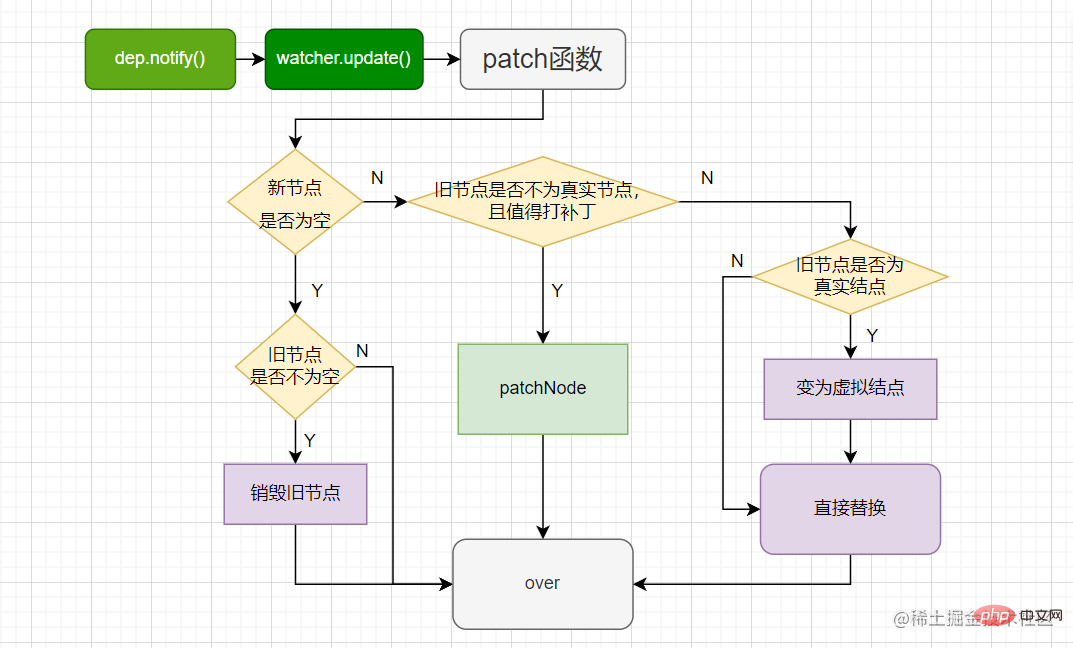
sameNode appears in it to determine whether it is worth giving it to us Patch, if it is not worth it, follow the above steps to replace it. Let’s find the source code address of this functionfunction sameVnode(a, b) {
return (
a.key === b.key && ----------------------key值相等, 这就是为什么我们推荐要加上key,可以让判断更准确
a.asyncFactory === b.asyncFactory &&
((a.tag === b.tag && ---------------------标签相等
a.isComment === b.isComment && ---------是否为注释节点
isDef(a.data) === isDef(b.data) && ----比较data是否都不为空
sameInputType(a, b)) || ---------------当标签为input的时候,需要比较type属性
(isTrue(a.isAsyncPlaceholder) && isUndef(b.asyncFactory.error)))
)
}patchVNode function function patchVnode(...
) {
if (oldVnode === vnode) { //两个节点一致,啥也不用管,直接返回
return
}
....
if (
//新旧节点都是静态节点,且key值相等,则明整个组件没有任何变化,还在之前的实例,赋值一下后直接返回
isTrue(vnode.isStatic) &&
isTrue(oldVnode.isStatic) &&
vnode.key === oldVnode.key &&
(isTrue(vnode.isCloned) || isTrue(vnode.isOnce))
) {
vnode.componentInstance = oldVnode.componentInstance
return
}
const oldCh = oldVnode.children //获取旧节点孩子
const ch = vnode.children //获取新节点孩子
if (isUndef(vnode.text)) { //新节点没有文本
if (isDef(oldCh) && isDef(ch)) { //旧节点孩子和新节点孩子都不为空
if (oldCh !== ch) //旧节点孩子不等于新节点孩子
updateChildren(elm, oldCh, ch, insertedVnodeQueue, removeOnly) //重点----比较双方的孩子进行diff算法
} else if (isDef(ch)) { //新节点孩子不为空,旧节点孩子为空
....
addVnodes(elm, null, ch, 0, ch.length - 1, insertedVnodeQueue) //新增节点
} else if (isDef(oldCh)) { //新节点孩子为空,旧节点孩子不为空
removeVnodes(oldCh, 0, oldCh.length - 1) //移除旧节点孩子节点
} else if (isDef(oldVnode.text)) { //旧节点文本为不为空
nodeOps.setTextContent(elm, '') //将节点文本清空
}
} else if (oldVnode.text !== vnode.text) { //新节点有文本,但是和旧节点文本不相等
nodeOps.setTextContent(elm, vnode.text) //设置为新节点的文本
}
}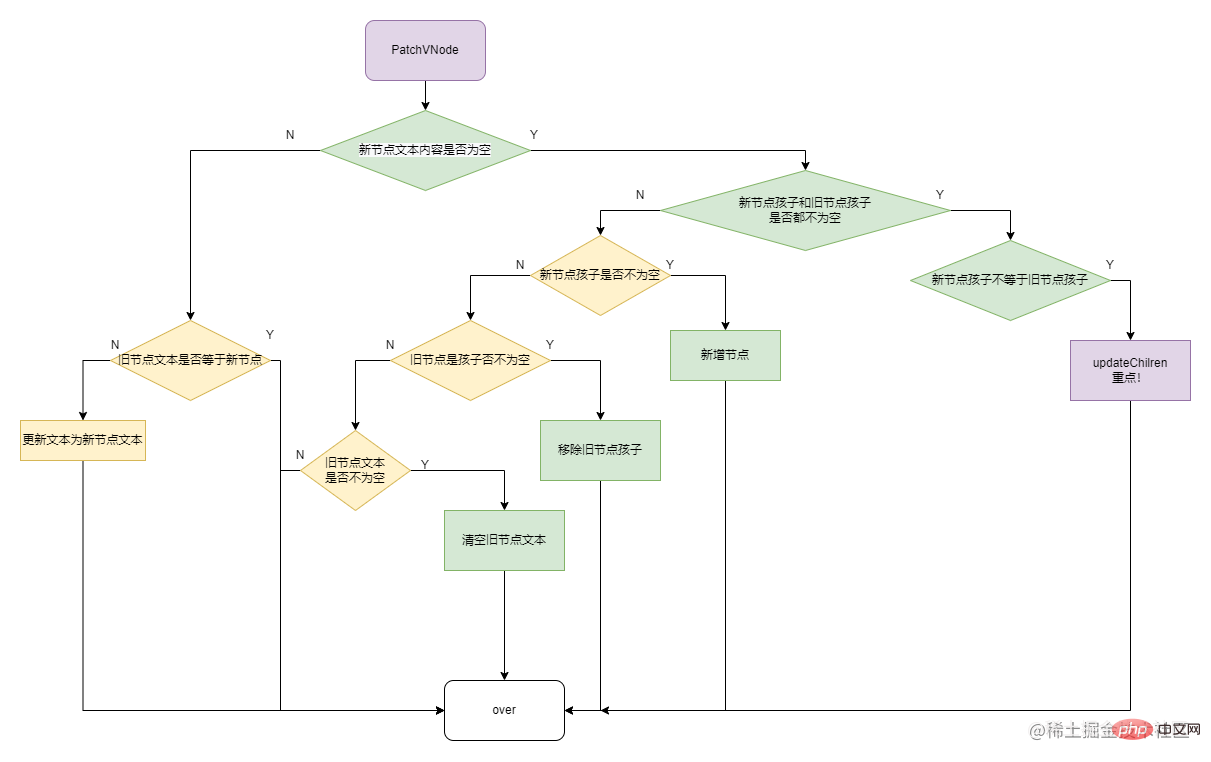
oldStartIdx, newStartIdx points to the old node head, the new node head, the initial value is 0 oldEndIdx, newEndIdx points to the end of the old node, the end of the new node, the initial value is length-1 let oldStartIdx = 0 //旧头指针
let newStartIdx = 0 //新头指针
let oldEndIdx = oldCh.length - 1 //旧尾指针
let newEndIdx = newCh.length - 1 //新尾指针
let oldStartVnode = oldCh[0] //旧头结点
let oldEndVnode = oldCh[oldEndIdx] //旧尾结点
let newStartVnode = newCh[0] //新头结点
let newEndVnode = newCh[newEndIdx] //新尾结点
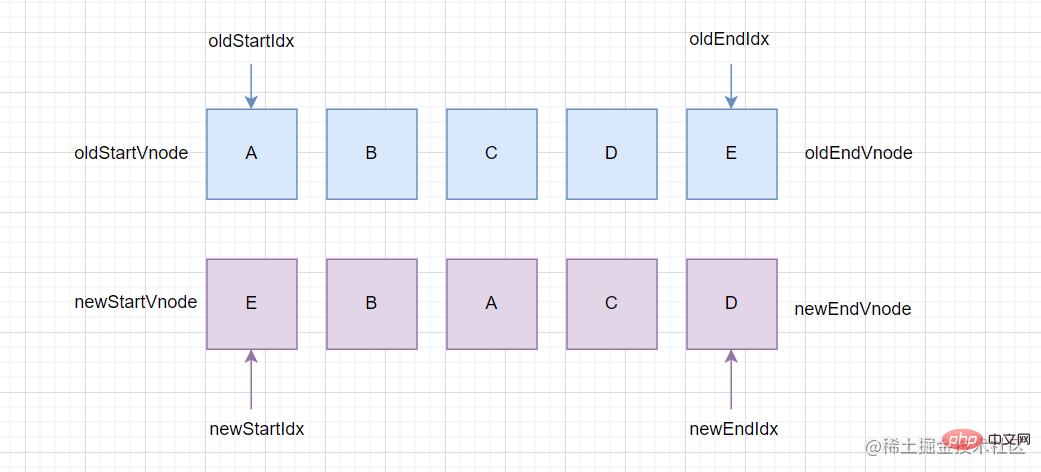
Note: As long as you can hit one here,Practice it, just take the random examples aboverestart, if you can't hit any of them, go to the next link. , Instead of continuing to judge one by one
function updateChildren(){ ·.... //好戏从这里开始看 //只要满足 旧头指针<=旧尾指针 同时 新头指针<= 新尾指针 -- 也可以理解为不能交叉 while (oldStartIdx <= oldEndIdx && newStartIdx <= newEndIdx) { //这里进行一个矫正,是应该在循环的过程中,如果进入key表查询的话复用后会将旧节点置空(后面会说),所以这里会对其进行一个处理 if (isUndef(oldStartVnode)) { //旧头结点为空 oldStartVnode = oldCh[++oldStartIdx] // 往右边走 } else if (isUndef(oldEndVnode)) { //旧尾结点为空 oldEndVnode = oldCh[--oldEndIdx] //往左边走 //step1 } else if (sameVnode(oldStartVnode, newStartVnode)) { //比较旧头和新头,判断是否值得打补丁 patchVnode(...) //打补丁 oldStartVnode = oldCh[++oldStartIdx] //齐头并进向右走 newStartVnode = newCh[++newStartIdx] //齐头并进向右走 //step2 } else if (sameVnode(oldEndVnode, newEndVnode)) { //比较旧尾和新尾, 判断是否值得打补丁 patchVnode(...) //打补丁 oldEndVnode = oldCh[--oldEndIdx] //齐头并进向左走 newEndVnode = newCh[--newEndIdx] //齐头并进向左走 //step3 } else if (sameVnode(oldStartVnode, newEndVnode)) { //比较旧头和新尾,判断是否值得打补丁 patchVnode(...) //打补丁 //补完移动节点 canMove && nodeOps.insertBefore(parentElm,oldStartVnode.elm,nodeOps.nextSibling(oldEndVnode.elm)) oldStartVnode = oldCh[++oldStartIdx] //旧头向右走 newEndVnode = newCh[--newEndIdx] //新尾向左走 //step4 } else if (sameVnode(oldEndVnode, newStartVnode)) { //比较旧尾和新头,判断是否值得打补丁 patchVnode(...) //打补丁 //补完移动节点 canMove && nodeOps.insertBefore(parentElm, oldEndVnode.elm, oldStartVnode.elm) oldEndVnode = oldCh[--oldEndIdx] //旧尾向左走 newStartVnode = newCh[++newStartIdx] //新头向右走 }
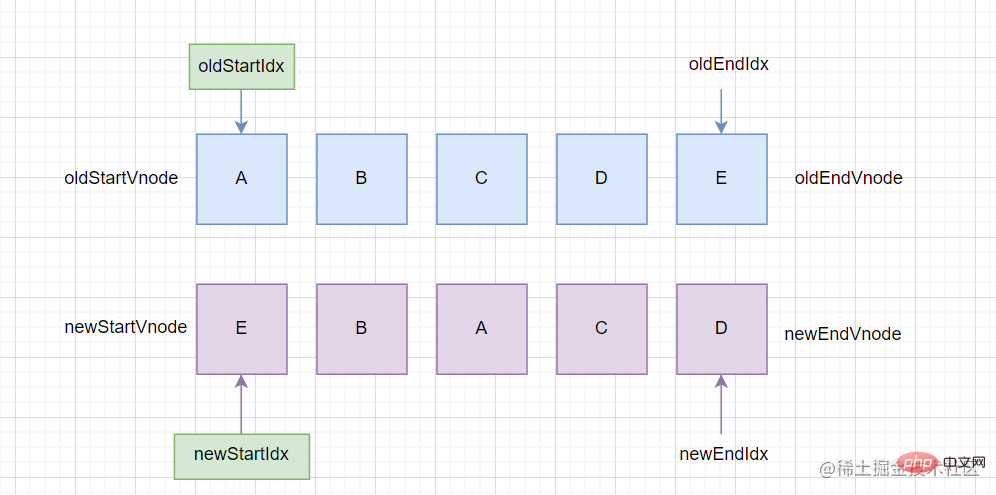
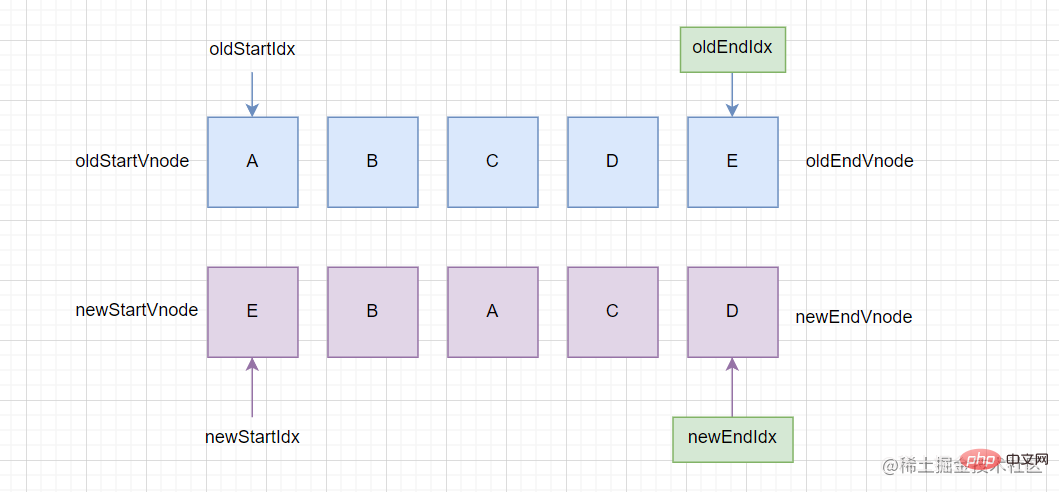
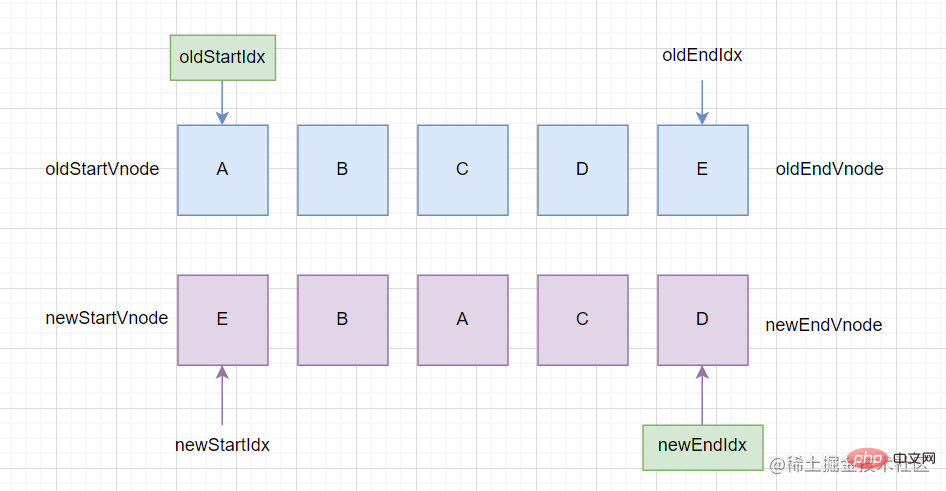 ##
##

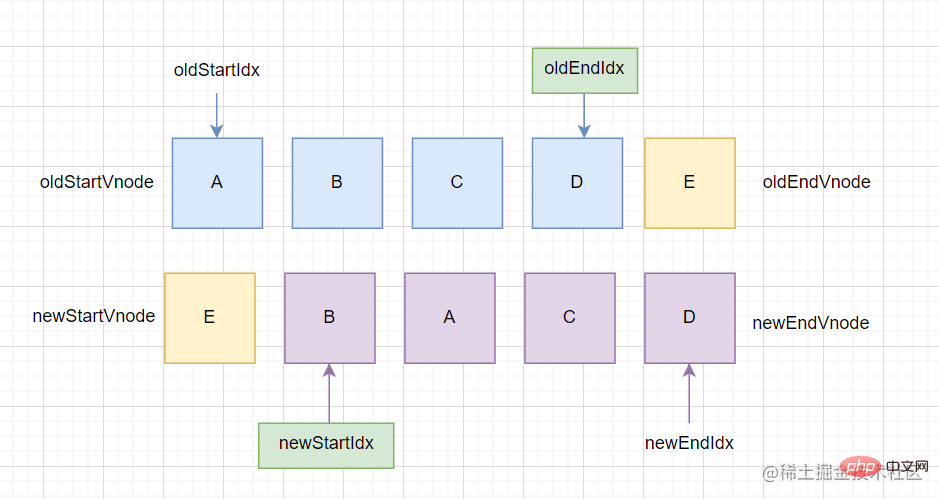
oldEndInx和newEndInx齐头并进向左走(注意这里是不用去移动节点的哦)(左), 然后重开,在step2再次命中...(右)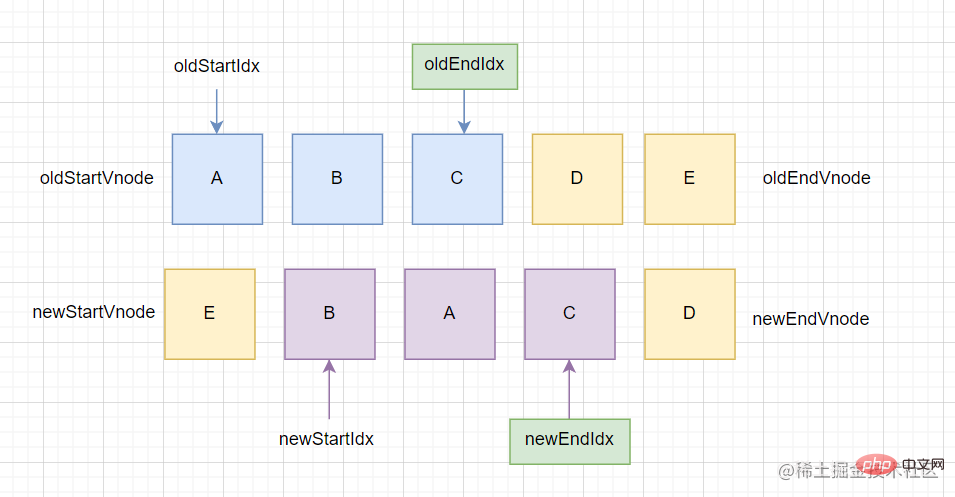

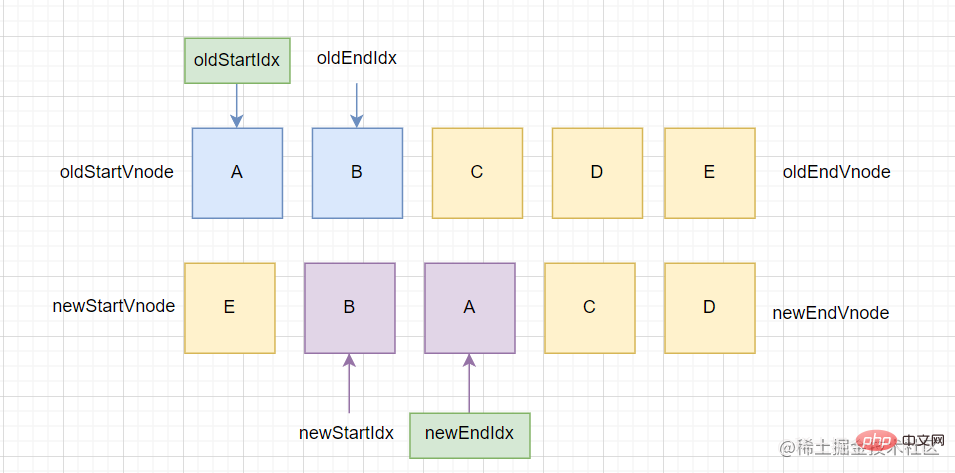
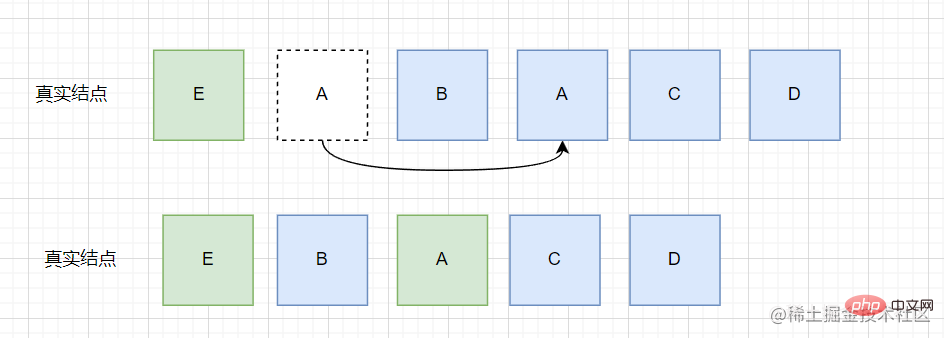
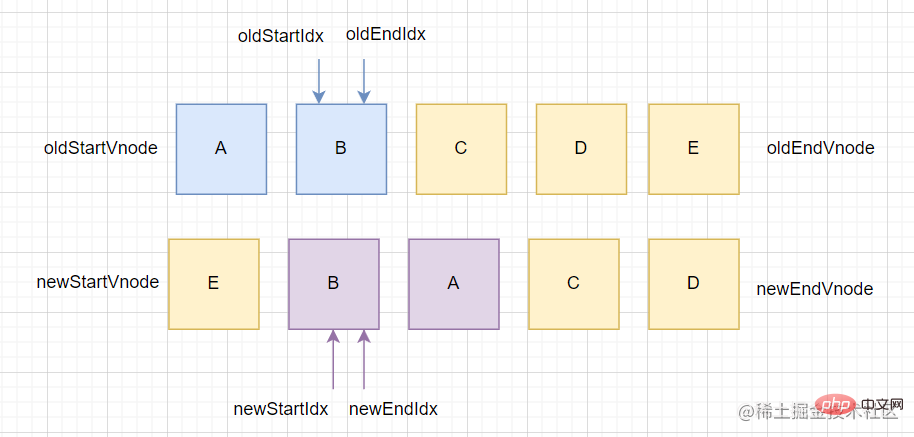
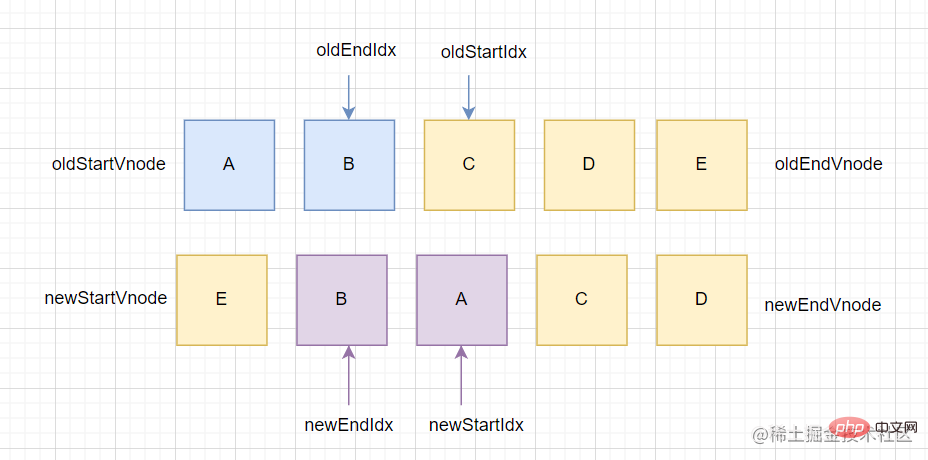
- 通过上面这个例子,我们把四种情况都命中了一下(一开始随便画的图没想到都命中了哈哈哈),也成功通过复用节点将真实结点变为预期结果,这里便是双端diff一个核心体现了
- 但是如果四种情况都没有命中的呢(如图下)
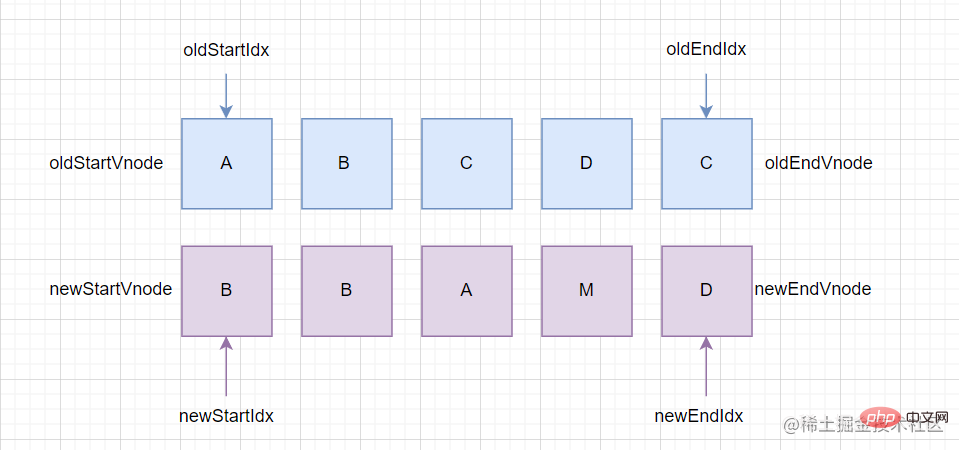
- 则会走向我们最后一个分支,也就是后面介绍的列表寻找

createKeyToOldIdx函数function createKeyToOldIdx(children, beginIdx, endIdx) {
let i, key
const map = {} //初始化一个对象
for (i = beginIdx; i <= endIdx; ++i) { //从头到尾
key = children[i].key //提取每一项的key
if (isDef(key)) map[key] = i //key不为空的时候,存入对象,键为key,值为下标
}
return map //返回对象
}
//所以该函数的作用其实就是生成了一个节点的键为key,值为下标的一个表findIdxInOld函数 function findIdxInOld(node, oldCh, start, end) {
//其实就是进行了一个遍历的过程
for (let i = start; i < end; i++) {
const c = oldCh[i]
if (isDef(c) && sameVnode(node, c)) return i //判断是否有值得打补丁的节点,有则返回
}
} let oldKeyToIdx, idxInOld, vnodeToMove, refElm;
....
else {
if (isUndef(oldKeyToIdx))
oldKeyToIdx = createKeyToOldIdx(oldCh, oldStartIdx, oldEndIdx) //传入的是旧节点孩子,所以生成了一个旧节点孩子的key表
//使用三目运算符--- 这里也是要使用key的原因,key有效的话可以通过表获取,无效的话则得进行比遍历比较
idxInOld = isDef(newStartVnode.key) //判断新头结点的key是否不为空--是否有效
? oldKeyToIdx[newStartVnode.key] //不为空的的话就到key表寻找该key值对象的旧节点的下标
: findIdxInOld(newStartVnode, oldCh, oldStartIdx, oldEndIdx) //遍历寻找旧节点数组中是否有和新头结点值得打补丁的节点,有的话则赋值其下标给idxInOld(不通过key)
if (isUndef(idxInOld)) { //发现找不到了就直接创建新真实节点
createElm(...)
} else { //找到了
vnodeToMove = oldCh[idxInOld] //找到该下标对应的节点
if (sameVnode(vnodeToMove, newStartVnode)) { //进行一个比较判断是否值得打补丁
patchVnode(...) //打补丁
oldCh[idxInOld] = undefined //置空,下次生成表就不会把它加进去
canMove &&nodeOps.insertBefore( parentElm, vnodeToMove.elm,oldStartVnode.elm ) //移动节点
} else {
//不值得打补丁,创建节点
createElm(...)
}
}
newStartVnode = newCh[++newStartIdx] //新头指针向前一步走
}
} //--- while循环到这里key表key有效的话,就拿新头节点的key去旧节点的key表找,找不到就创建新的真实节点, 找得到的话就判断是否值得打补丁,值得的话就打补丁后复用节点,然后将该旧节点孩子值置空,不值得就创建新节点key无效的话,则去遍历旧节点数组挨个进行判断是否值得打补丁,后续跟上述一样也使用一下上面的例子运用一下这个步骤,以下都为key有效的情况
(重新放一下图,方便看)
newStartVnode的key值为B,找到旧节点孩子该节点下标为1,则去判断是否直接打补丁,值得的话将该旧节点孩子置空再在A前面插入B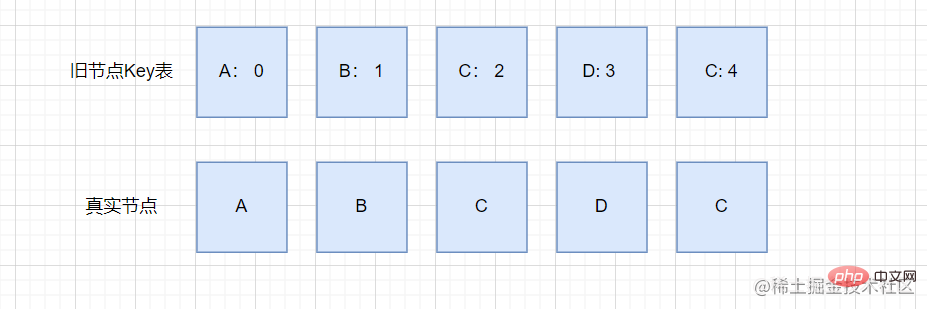
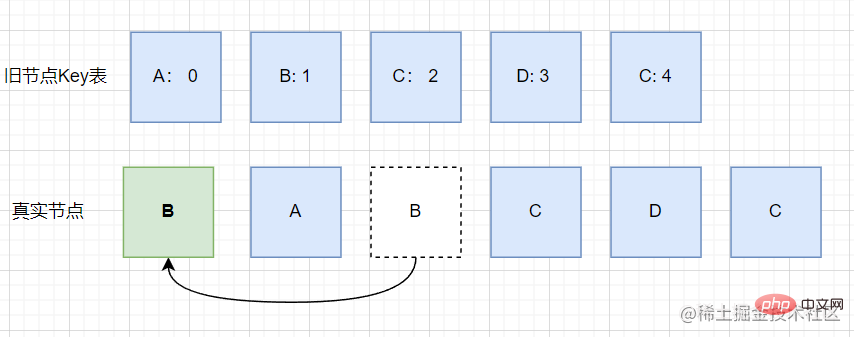
右图的表中B没有变为undefined是因为表示一开始就生成的,在下次进入循环的时候生成的表才会没有B
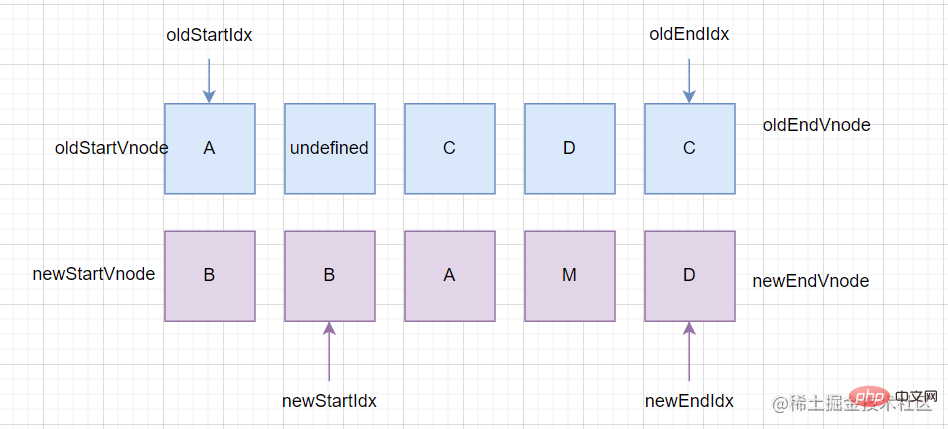

undefined(图右),直接向右走,重开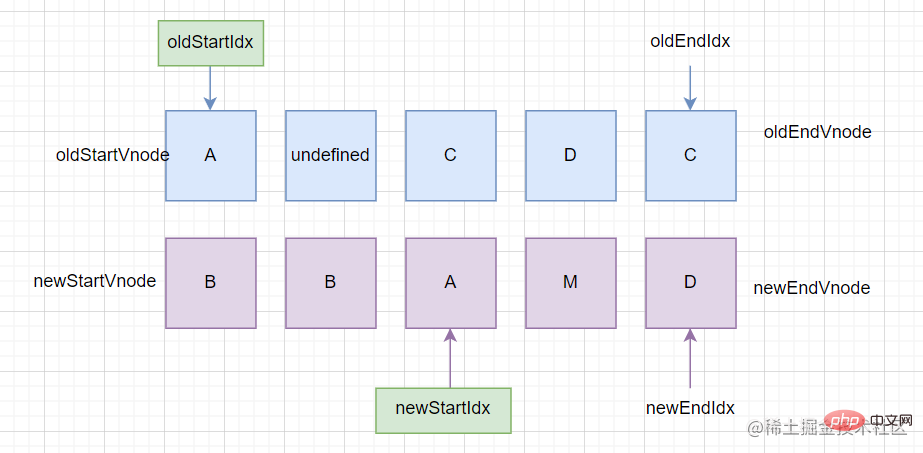
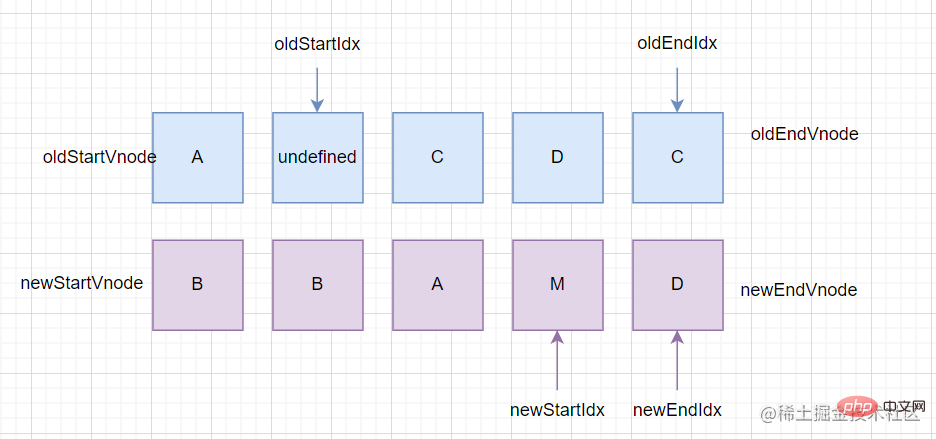
key表,发现找不到,于是创建新节点M插入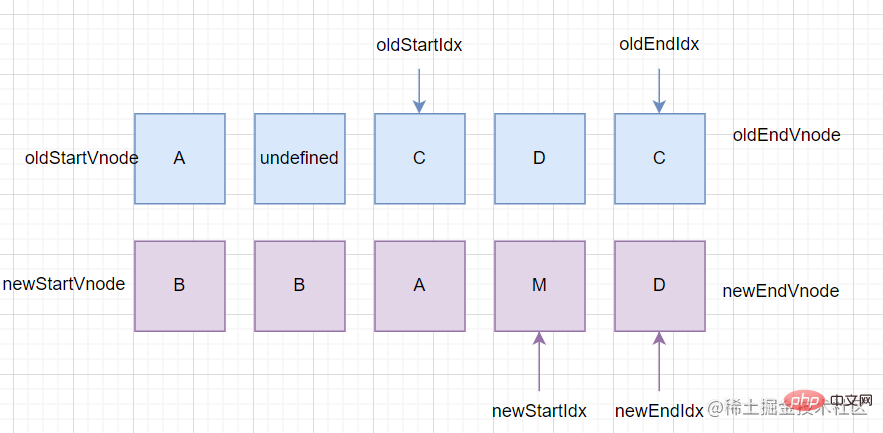

key表去寻找,找到了D,于是移动插入,旧节点孩子的D置空,同时新头向前一步走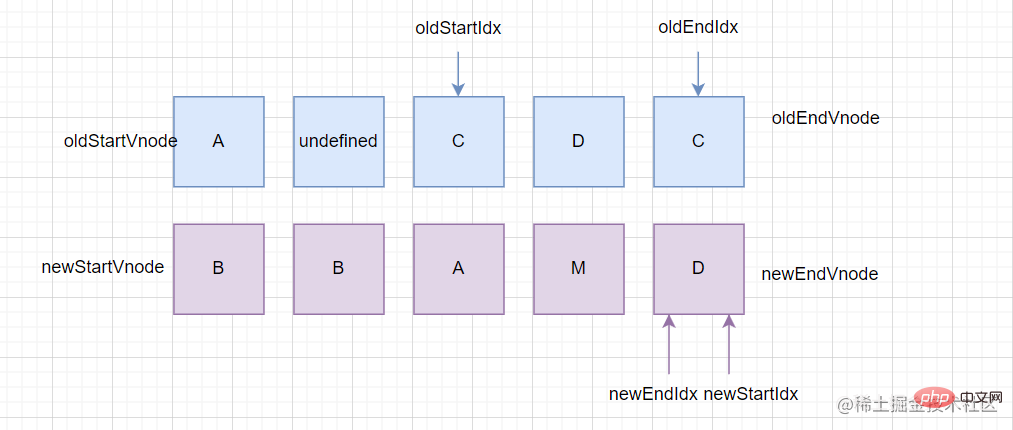

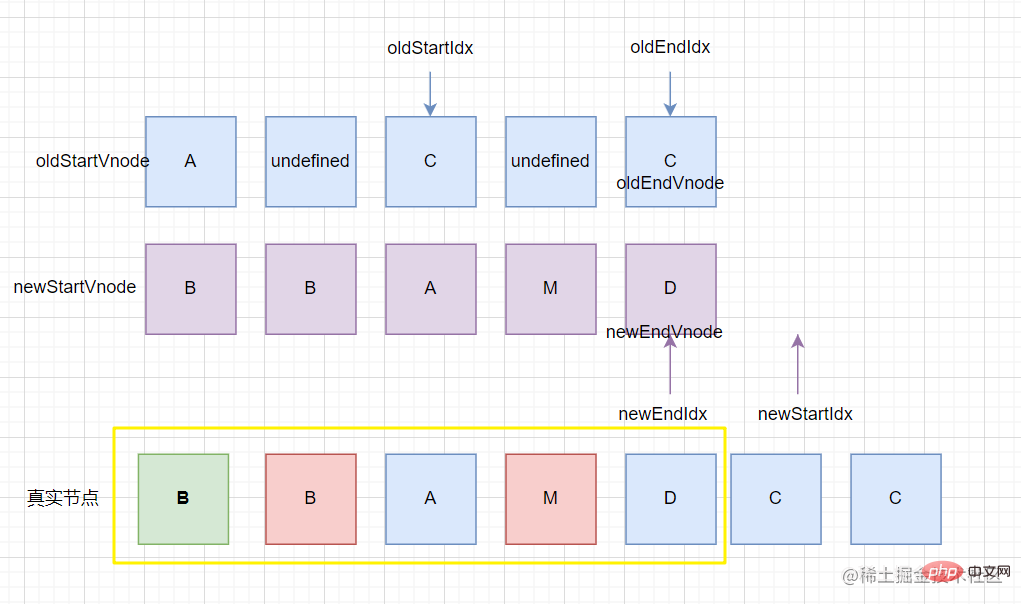
if (oldStartIdx > oldEndIdx) { //旧的交叉了,说明新增的节点可能还没加上呢
refElm = isUndef(newCh[newEndIdx + 1]) ? null : newCh[newEndIdx + 1].elm
addVnodes(....) //新增
} else if (newStartIdx > newEndIdx) { //新的交叉了,说明旧节点多余的可能还没删掉呢
removeVnodes(oldCh, oldStartIdx, oldEndIdx) //把后面那一段删掉
}
到这里updateChildren函数就结束喽,自己推导一下节点的变化就会很清晰啦
(学习视频分享:编程基础视频)
The above is the detailed content of Understand the vue2 diff algorithm in one article (with pictures). For more information, please follow other related articles on the PHP Chinese website!